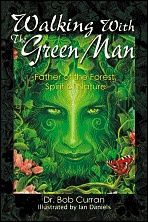
Dr. Bob Curran's Walking with the Green Man takes the reader through churches and villages of the British Isles, Mediterranean and Near Eastern lore, Mesopotamian temples, and contemporary mixed media as he shows us the broad and pervasive influence of the figure he calls the Green man. He writes: "It is a walk through the mythology, legend, and history that have shaped and molded us all as a people on the planet. And at its end, we may know something fundamental about ourselves. It is therefore a walk that is well worth taking (p. 17).” Sadly, his claim is too large and broad and what has happened is that serious scholars will dismiss this book as trash, and those of us who might have an interest in this archetypal figure will feel insulted.
The book is divided into four chapters. The first, "The Thing in the Forest," is an overview of the history, lore, traditions, and interesting personages associated with the Green Man. The obvious underlying focus is on humanity's "fundamental split with the Natural world." What is even more obvious is that this split was of enormous detriment, creating a rift in the harmony that has never been since healed. Chapter Two, "The Lurker Amongst the Leaves," looks at pagan and Christian treelore in Europe and the Near East -- this includes Yggdrasil, the Garden of Eden, Herne, the Wild Hunt, Enkidu, Osiris, Dionysus, Merlin, and others. Chapter Three, "Echoes from the East," follows themes from the first two chapters into the rest of the world, although lore from Europe finds its way into this chapter as well (get used to it; the author spends the entire book meandering and going off-focus). It is here that we meet Europe's dryads, satyrs, and get information on djinns and Al-Khidir. We also encounter the Kirtimukha of Tibetan Buddhism and intriguing nature deities from India, Borneo, Papua New Guinea, ancient Mesoamerica, and Africa. Chapter Four ("Unholy Terrors") begins with more lore then turns to Green Man art in English churches and concludes with an overview of contemporary mixed media. Where the ‘unholy’ and ‘terror’ part happens, I have no idea.
All that I have described is not so bad, you might think. So it’s a little muddled, maybe not pristinely laid out – lots of folklore is like that . . . look at The White Goddess for heaven’s sake! My reply: this book is not allegory, nor poetry: it is a study, a scholarly work that presents to the reader the knowledge gathered so as to enlighten.
There is not one, not ONE, footnote or reference to support any of the claims made, stories told, or quotations repeated. The closest we achieve is a list of ‘Further Reading’ comprised of 50 books. So, I can’t check on the source of Curran’s statement that a beard was a “. . . hazardous thing to sport in battle. In hand-to-hand combat an opponent could grab the warrior’s beard (if it were long enough) and hold him until a fatal blow to the head was delivered. (p. 29)” or why he links the Celtic Sheela-Na-Gigs with the “Women of Willendorf” figures as being of similar iconography. (They aren’t particularly, at least not to the average person’s eye.)
What is the most frustrating thing is that Dr. Curran does gather up and present a world of information about the Green Man and says some truly wonderful things about this archetype. "There is still a notion, locked away in some almost forgotten part of our mind that old and powerful forces might still exist and that they can be experienced through the often-overwhelming power of raw Nature. (p. 195)”
I can not recommend this book, I am sorry to say, although the illustrations provided by Ian Daniels are wonderful.
~review by Lisa Mc Sherry
Author: Bob Curran
New Page, 2007
